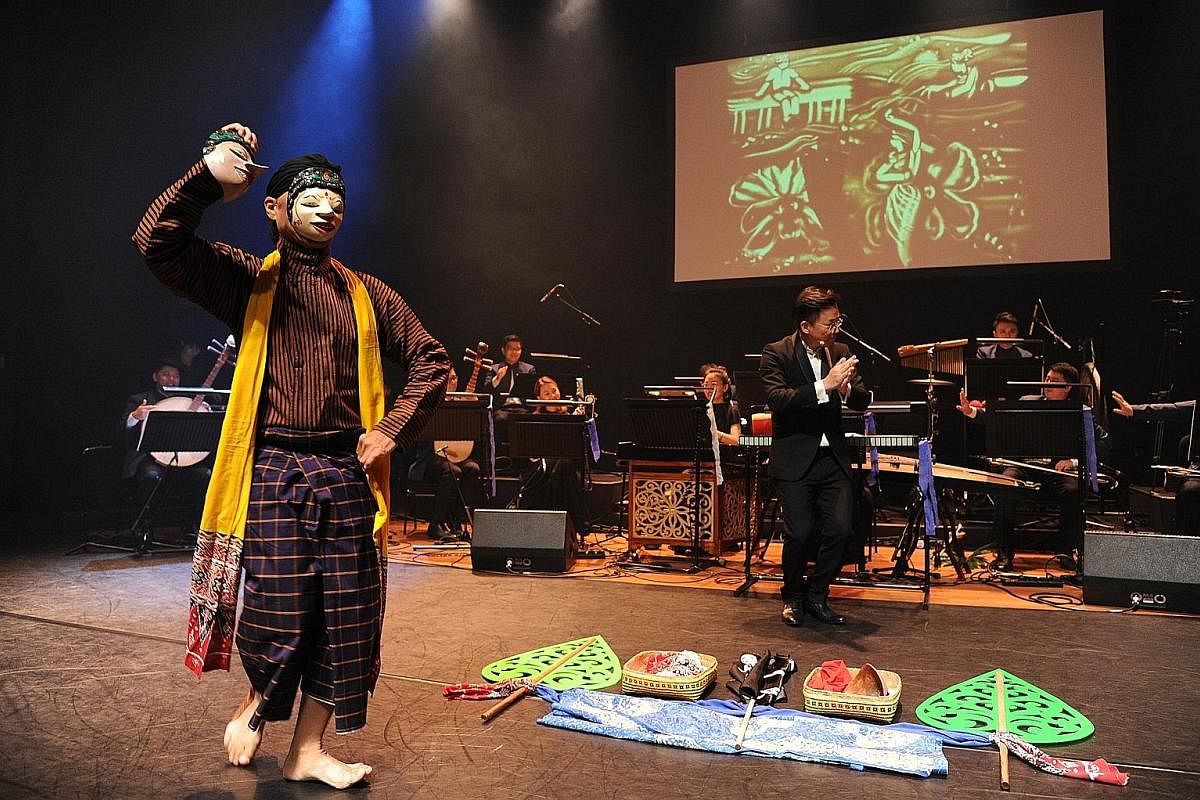Contemporary ethnic music groups woo young audiences
Contemporary ethnic music groups band together in their love of traditional instruments and passion to breathe modern sounds into their works

Playing traditional instruments such as the Chinese pipa, Indian flute and Malay rebana, a growing number of young Singapore musicians are upending expectations of what ethnic music should sound like.
There are at least eight groups here that are breathing new life into music played with traditional instruments, each with a distinct identity that appeals to a different audience.
For example, the six members of The Teng Ensemble, who play instruments such as the pipa (Chinese string instrument) and sheng (Chinese mouth organ) as well as the guitar and cello, are often sharply dressed with coiffed hair.
The group, known for its modern and electronic arrangements of folk and community songs such as Di Tanjong Katong and Chan Mali Chan, was fully booked for events after it was formed in 2009.
"We are known for our East-West music. But when we started, people were amazed that these two genres could mix," says Samuel Wong, 34, who plays the pipa and is Teng's artistic director.
In five-piece band Raghajazz, the jazz genre is given a unique spin with the inclusion of the bansuri (sideblown Indian flute) and the tabla. It was set up in 2009 by bansuri player Raghavendran Rajasekaran.
On the more experimental end is six-year-old SA, a trio of musicians who explore audio improvisations with instruments such as the dizi (Chinese flute) and guzheng (Chinese stringed instrument), alongside drums and electronic equipment.
"The underlying goal was to break the boundaries of Chinese music," says SA's guzheng player Natalie Alexandra Tse, 30, of the band's origins. "But as we've progressed as musicians, we are now more focused on exploring and creating our own sound."
The National Arts Council is supportive of these contemporary ethnic music groups, which have been part of the council's programmes, such as the Arts In Your Neighbourhood initiatives, which bring art to the doorstep of Singaporeans.
In April, the council announced plans to redevelop the ageing Stamford Arts Centre into a venue focusing on traditional arts, including contemporary reinventions of the form. It will re-open next year.
The council is inviting arts groups interested to be housed in the centre to apply for the 11 available units. Applications close on Aug 31.
Esplanade - Theatres on the Bay has also supported some of these groups by giving them opportunities to perform at its events and festivals. On July 16, for example, is a collaboration between SA and visual art and sound duo Nada for Esplanade's annual Baybeats festival.
The Esplanade also recently programmed Malay percussion group Nadi Singapura in its Feed Your Imagination programme for schools.
Nadi was co-founded by percussionist Riduan Zalani, 32, in 2011 to take Malay percussion out of its more conventional religious and processional setting and present it in more theatrical displays. Its musicians also act, dance and sing.
Mr Joseph Tan, head of Esplanade's programme management (music and planning), says: "All these efforts have made the music scene more vibrant and pushed the envelope of what music can be. When a group such as Nadi employ new techniques in their presentations, members of the scene learn from them and are inspired."
The various groupsare united in their passion to spread the love of traditional instruments, especially to the younger generation.
Many lament the fact that parents tend to enrol their children for lessons in more popular and accessible instruments such as the piano and guitar.
Yang Ji Wei, 36, Teng's sheng soloist and executive director, says: "People don't really feel the need to listen to traditional instruments anymore, especially in a concert hall setting. They have a stereotypical mentality that Chinese instrumental music is related to funerals or wedding processions."
Often, these musicians are creative in developing their art form and reaching out to new audiences.
In Yang's case, he painted his mouth organ, the sheng, a cool shade of white, which made people curious about the instrument.
The Teng Ensemble also produces slick music videos - a recent one showcasing an evolution of Disney princess songs was featured on Mashable and has received almost one million views on Facebook.
And when six-man world music outfit Kulcha played a cover of electro-pop hit Chandelier by Australian singer Sia at the Esplanade, gambus player Ismahairie Putra Ishak, 32, had children wondering if he was playing a guitar.
"I said, 'No, this is the grandfather of the guitar.' They looked up to us like rock stars," he recalls.
Kulcha's members play about 10 instruments, including the bass guitar, violin, angklung, bansuri and Sundanese kendang or two-headed drum.
While courting new audiences is a work in progress, what helps musicians is the knowledge that they are not alone. Many collaborate on ad- hoc projects or are members of multiple bands. For example, over the weekend, percussionist Cheryl Ong from SA performed with Raghavendran and Ismahairie for the Singapore Botanic Gardens' Heritage Festival. Raghavendran plays in Raghajazz and Kulcha, while Ismahairie, who is with Kulcha, also plays in Malay ethnic group Orkestar Trio.
Banding together gives them strength in numbers against purists, who may not like traditional instruments being played in new ways.
Raghavendran says half in jest: "I think if I were in India, I would be shunned. But in Singapore, I have a lot of friends who are doing the same stuff as me. The first person who taught me to play the blues on the flute was Andy Chia from SA."
Many of these musicians pay homage to their cultural roots and history in fresh and creative ways.
Ten-year-old Ding Yi Music Company, for example, will present a concert in December inspired by dragon kilns, or traditional brick kilns which resemble the belly of a dragon. The musicians will make music using clay pots fired in the kiln. There are only two dragon kilns left in Singapore - from more than 20 - and they are part of Chinese cultural heritage, especially that of the Teochew community, who brought the practice with them from China.
Dedric Wong, 31, Ding Yi's general manager and assistant conductor, says: "In Chinese music, the roots are important. You have to step onto the roots to do other things."
Riduan adds: "Culture is active. It needs to evolve. Singapore is a metropolitan, multicultural city. We don't sound like anybody else, which I think is a strength - if you harness it properly."
Join ST's Telegram channel and get the latest breaking news delivered to you.
A version of this article appeared in the print edition of The Straits Times on July 04, 2017, with the headline Contemporary ethnic music groups woo young audiences. Subscribe

